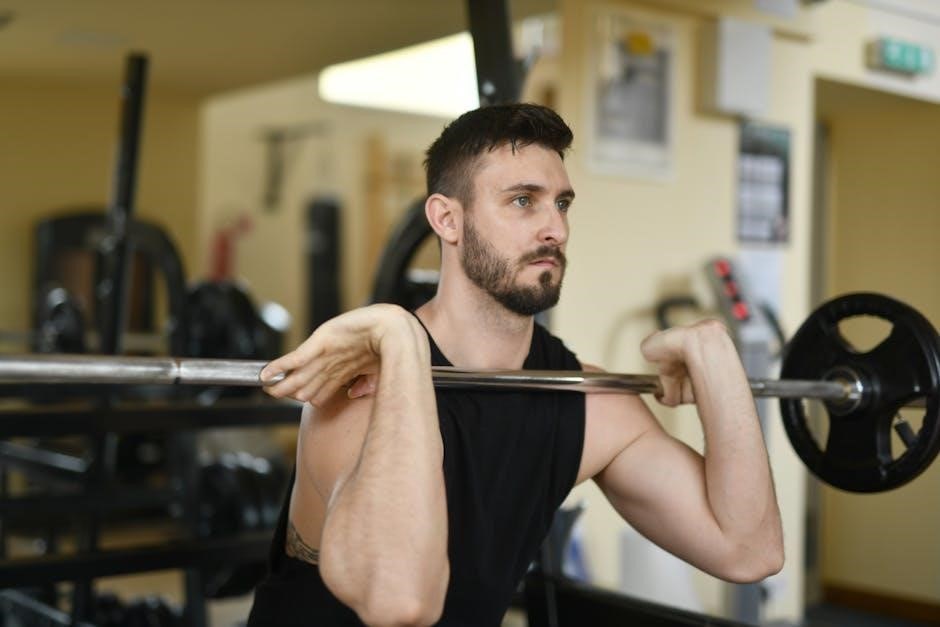
shoulder pendulum exercises pdf
Shoulder pendulum exercises are a gentle, effective way to improve shoulder mobility and strength after injury or surgery. Using the arm’s weight and momentum, these exercises promote healing without straining the muscles, making them a cornerstone of recovery programs.
Definition and Purpose
Shoulder pendulum exercises, also known as Codman’s exercises, involve gentle, controlled movements of the arm to promote healing and mobility in the shoulder joint. These exercises are typically performed while leaning forward, allowing the arm to hang freely and swing like a pendulum. The primary purpose is to enhance flexibility, strength, and range of motion without actively engaging the injured muscles, making them ideal for post-injury rehabilitation or post-surgery recovery. By using gravity and momentum, pendulum exercises help restore function to the shoulder while minimizing strain, providing a foundation for more advanced movements as recovery progresses.

Benefits of Shoulder Pendulum Exercises
These exercises enhance shoulder mobility, strength, and flexibility, promoting recovery after injuries or surgeries. They improve joint function and reduce stiffness, aiding in overall shoulder health and stability.
Improved Mobility
Shoulder pendulum exercises significantly enhance joint mobility by promoting gentle, controlled movements. These exercises help increase the range of motion, reducing stiffness and encouraging fluid movement. By allowing the arm to swing freely, the shoulder joint gradually becomes more flexible, easing limitations caused by injury or surgery. Regular practice improves circulation and relaxes tight muscles, further boosting mobility. Over time, patients can perform daily activities with greater ease, as the shoulder regains its natural movement capabilities. Consistency is key to achieving lasting improvements in mobility and overall shoulder function.
Enhanced Strength
Shoulder pendulum exercises play a crucial role in building strength around the shoulder joint without putting excessive strain on the muscles. By utilizing the weight of the arm and gradual movements, these exercises help strengthen the muscles and ligaments, improving overall shoulder stability. Over time, the controlled swings and rotations enhance the endurance of the shoulder muscles, making them more resilient to daily activities and physical demands. Additionally, incorporating light weights or resistance can further amplify strength gains, promoting a faster return to normal function and sports activities. Consistent practice ensures progressive strengthening, aiding in long-term recovery and injury prevention.
Increased Flexibility
Shoulder pendulum exercises are highly effective for enhancing flexibility, particularly in the early stages of recovery. By performing gentle swings and rotations, these exercises help improve the range of motion in the shoulder joint. The controlled movements gradually stretch the muscles and connective tissues, reducing stiffness and promoting smoother joint function. Regular practice of circular, side-to-side, and forward-backward swings can significantly increase flexibility, allowing for better mobility in everyday activities. Over time, consistent practice enhances joint lubrication and reduces rigidity, making the shoulder more adaptable to movement and less prone to discomfort or injury.

Proper Technique for Performing Pendulum Exercises
Stand with feet apart, bend at the waist, and support your body on a sturdy object with your unaffected arm. Let the affected arm hang relaxed, then gently swing it using your body’s momentum, avoiding muscle strain.
Standing Position
For the standing position, place your feet shoulder-width apart and stand beside a sturdy table or chair. Lean on the table with your unaffected arm for support. Ensure your body is stable, with knees slightly bent to maintain balance. Keep your spine straight and engage your core to prevent any strain. Your affected arm should hang freely by your side, allowing it to swing naturally without resistance. This position ensures your shoulder joint is properly aligned, enabling effective movement and minimizing discomfort during the exercise.
Bending at the Waist
Bending at the waist is essential for proper pendulum exercises. Stand with your feet shoulder-width apart and slowly lean forward at the hips, keeping your back straight. Allow your affected arm to hang freely toward the floor while supporting yourself with your unaffected arm on a table or chair. Ensure your bend is gentle and does not cause strain. This position allows your arm to swing naturally, promoting mobility and reducing stiffness in the shoulder joint. Maintain a relaxed posture and avoid tensing your muscles, as this can hinder the exercise’s effectiveness.
Arm Positioning
Proper arm positioning is crucial for effective pendulum exercises. Let your affected arm hang straight down from your shoulder, completely relaxed, with your palm facing your thigh. Your unaffected arm should support your body by resting on a table or chair. Ensure your arm is free to swing without restriction, avoiding any tension in the shoulder or arm muscles. Perform small, gentle swings, gradually increasing the range as comfort allows. Hold this position for the duration of the exercise, maintaining a steady and controlled movement. This positioning helps maximize the therapeutic benefits of the pendulum exercise for your shoulder.

Types of Pendulum Exercises
Pendulum exercises include circular movements, side-to-side swings, and forward-backward swings. These variations target different aspects of shoulder mobility and strength, promoting comprehensive recovery and flexibility.
Circular Movements
Circular movements involve swinging the arm in a small, controlled circle, typically about one foot in diameter. This exercise enhances joint mobility and promotes healing by gently stretching the shoulder muscles and improving synovial fluid circulation. Patients are often advised to perform 10 revolutions in each direction, once daily, to maximize benefits. It’s important to maintain relaxation and avoid forced movements, allowing the arm to move naturally with the body’s rhythm. This variation is particularly effective for restoring range of motion and reducing stiffness, especially in the early stages of recovery or rehabilitation.
Side-to-Side Swings

Side-to-side swings involve gently moving the arm from one side of the body to the other while bending at the waist. This exercise is performed by leaning forward, allowing the affected arm to hang freely, and using the body’s momentum to create a smooth, pendulum-like motion. Patients are typically advised to perform 10-15 repetitions, 2-3 times daily, to improve shoulder joint mobility and reduce stiffness. It’s essential to keep the arm relaxed and avoid forcing the movement, as this can exacerbate discomfort. Side-to-side swings are particularly beneficial for restoring range of motion and promoting gentle stretching of the shoulder muscles.
Forward and Backward Swings
Forward and backward swings are a variation of pendulum exercises that focus on moving the arm in a straight line, alternating between front and back directions. To perform this exercise, stand or bend at the waist, allowing the affected arm to hang freely. Gently rock your body weight to create a smooth, controlled motion, swinging the arm forward and backward. This exercise helps improve shoulder flexibility and reduces stiffness. It is recommended to perform 10-15 repetitions, 2-3 times daily, to enhance joint mobility and promote healing. Consistency and proper form are key to maximizing the benefits of this exercise.

When to Use Pendulum Exercises
Pendulum exercises are ideal for post-injury rehabilitation, post-surgery recovery, and managing chronic shoulder conditions. They gently restore mobility and strength without overloading the joint.
Post-Injury Rehabilitation
Pendulum exercises are highly effective for post-injury rehabilitation of the shoulder. They utilize the arm’s weight and momentum to promote gentle movement, reducing stiffness and improving mobility without overloading the joint. By leaning forward and using a stable surface for support, individuals can swing their arm in small circles or side-to-side motions, encouraging natural healing. These exercises are particularly beneficial for restoring range of motion and strength after injuries like dislocations or strains. They are often recommended 2-5 times daily, with 5-10 minute sessions, to gradually enhance flexibility and reduce pain. Always consult a physical therapist for personalized guidance.
Post-Surgery Recovery
Pendulum exercises are a key component of post-surgery recovery for the shoulder. They help restore mobility and strength without putting strain on repaired tissues. After surgeries like rotator cuff repairs, these exercises are often prescribed to prevent stiffness and promote healing. By leaning forward and using the unaffected arm for support, patients can gently swing the affected arm in small circles or side-to-side motions. This approach allows for controlled movement, enhancing flexibility and reducing discomfort. Typically performed 5 times daily in 5-10 minute sessions, these exercises are tailored to the patient’s progress and are essential for a successful recovery process under medical supervision.
Chronic Shoulder Conditions
Pendulum exercises are highly beneficial for individuals with chronic shoulder conditions, such as arthritis or tendonitis. These exercises help maintain shoulder mobility and strength without exertion, reducing stiffness and pain. By gently swinging the arm in small circles or side-to-side, patients can improve joint lubrication and flexibility; For chronic conditions, pendulum exercises are often performed daily to manage symptoms and prevent further deterioration. They are particularly useful for those who cannot perform more strenuous activities due to ongoing shoulder issues. Regular practice, even for a few minutes, can significantly enhance comfort and functionality in daily life, making them a valuable long-term management tool.

Additional Resources
Download our comprehensive Shoulder Pendulum Exercises PDF Guide for detailed instructions, illustrations, and expert tips to enhance your recovery journey and improve shoulder health effectively.
Downloading the PDF Guide
The Shoulder Pendulum Exercises PDF Guide is a valuable resource for anyone recovering from shoulder injuries or surgeries. This comprehensive guide provides detailed instructions, illustrations, and expert tips to help you perform pendulum exercises safely and effectively. It includes step-by-step directions for various movements, such as circular, side-to-side, and forward-backward swings, ensuring proper technique to avoid further injury. The guide is free to download and is designed to be user-friendly, making it accessible for both patients and physical therapists. By following the exercises outlined in the PDF, you can enhance your shoulder mobility, strength, and flexibility while promoting a smooth recovery process.